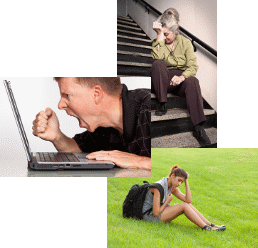|

|
untitled

CRANIOSACRAL
THERAPY and ADULTS and young
people with the labels ADHD/ADD
I'm
Victoria Behrends, and as a Craniosacral
therapist and HHP with years of experience in
education with adults and teens, I've seen
many adults who have some of the difficulties
described here--though they may or may not
"have" ADHD...it's an overused phrase for a
complex health problem often with only old
solutions. If you or someone you know finds
this information familiar or helpful, you can
call and speak to me about it, or make an
appointment to discuss possibilities and
strategies to help.
Call 760-753-1493 to ask
questions or to make an appointment, or go
to my contact page.
Adults
and young people who have been labeled with
"ADHD or ADD" often feel as if they are
battling the entire world. Many people with
these disorder symptoms have struggled for
most of their lives, and often without a clear
and accurate diagnosis. ADHD can be
misdiagnosed and may have underlying physical
disruption or trauma that can look like what
is seen as symptoms. Only some of these
characteristics for ADHD may include: low
self-esteem, distraction, rage, excessive
talking, restlessness, difficulty organizing
and completing tasks, lack of follow through,
and consistently losing things. Often
assumptions are made too soon in situations
where behavioral skills can be built or there
is a physical cause and solution. Focus
has often been on children due to scholastic and
obvious difficulties in that setting. There are
Federal and State laws in place that give
parents the right to object to all aspects of
school suggestion or coercion of drugs as a
solution or even evaluation with the assumption
that "it's ADHD/ADD".
Sensory disorders have a huge impact on
students of all ages, and not just in the
traditional academic college and high school and
elementary school setting, but also later
in training and workshops required in business,
technical and service employment. People
with the label ADHD/ADD are often angry and have low
self esteem not only due to the brain activity, but also
to the constant and ongoing criticism and
misunderstanding from others that can result. Most
people with this disorder have been experiencing this
for many years, especially if it has been unacknowledged
for most of that time. They have been seen as "lazy",
uncooperative, distracted, without a sense of deadlines,
plans, commitment and so much more. There is a definite
effect on their relationships, both personal and
professional. Often they have been consistently seen in
their childhood as being a "problem", which forms their
concept of self. So many with ADHD are often brilliant,
but without some way to deal with the disorder symptoms,
they find their potential unfulfilled and hampered by
the characteristics that hold them back or have them
make foolish and sometimes odd decisions.
There is
another factor---neurologist Dr. Robert Scaer , The
Body Bears
the Burden, The Trauma
Connection
presents the research that there is most often a
trauma, physical or emotional that is the primary
cause of this sensory disorder. Somatic
therapy then comes into the picture as a way to treat
ADHD and other labels that involve sensory disorders,
ie. Sensory Processing Disorder. Dr. Stephen Porges,
psychologist Peter Levine, Stanley Rosenberg and others
have worked with these concepts for some time now, but
mainstream treatment often does not include this
approach, relying primarily on drug treatment.
There is
some awareness of gluten intolerance and toxic foods
having an impact on attention deficits, but specific
trial and error and additional information from
nutritional tests can be implemented to make a
difference.
Individual
strategies can be developed and techniques in Craniosacral
Therapy can be used to strengthen, resource and release
those held back by these difficulties.
Support to substantially help those adults
with Attention Deficit symptoms will be offered with a
four point approach:
- Craniosacral Therapy,
to balance and
resource the system, and improve self-esteem and
self-control
- CRM, Comprehensive
Resource Modeling or Brainspotting, BSP, to identify and release
barriers that may be causing the symptoms and to provide
resourcing
- A specific Hair Analysis to research what may be
needed to strengthen and balance the system
- Strategy
Sessions , to further resolve
difficult characteristics after working with Craniosacral
therapy and Brainspotting
- Safe And Sound Protocol
- A new Listening Program, developed by Dr.
Stephen Porges
BSP
and CRM have been effective in treating ADHD/ADD,
especially when trauma appears to be the original source of
the Attention Disorder symptoms. The roots of survival
terror often play out in ADHD-like behavior that can
be changed with trauma resolution.
Craniosacral Therapy can often be the
first effective and valuable step to improvement in the
attention deficit disorders.
John Upledger, OD, a pioneer in the field of
craniosacral therapy, reported improvement on many levels
including "an increase in
self-esteem with a greater ability to exercise
self-control".
Upledger described: "Craniosacral
therapy can have a profoundly positive effect on brain and
spinal cord function. It has been used successfully in the
treatment of ADHD since 1975. Our clinical experience
suggests that structural restrictions in the body,
especially in the bones and membrane layers surrounding
the brain and spinal cord, may be the primary factor in a
significant number of such cases. These restrictions can
interfere with the normal movement of fluids and vital
nutrients into and out of the brain - nutrients that
enable the brain to function properly." Pathways
Magazine, 3/1/10

Frustration and deep sadness
often rises in children and
adults who are diagnosed with ADHD, complicating and adding
to the many things that impact their quality of life. Frequently there is a disconnect
in even accepting the concept that there ARE solutions or
directions to go in at all. There is a strong sense of
looking out at the world from a restricted place, trying to
break through to relief and clarity, and trying to move past
the negative perceptions of others.
In the words of
one adult with ADHD disorder symptoms:"Often I feel so isolated, and
cannot see any solutions & help I want to be a part of
something, to function better and do what I want, to be
happy, and not feel so different and weird ."
|

|